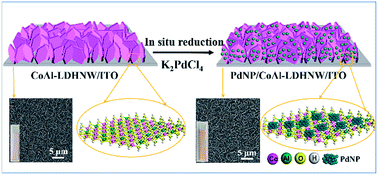Highly dispersed palladium nanoparticles generated in situ on layered double hydroxide nanowalls for ultrasensitive electrochemical detection of hydrazine†
Abstract
Rational design and fabrication of electrocatalytic nanomaterials is an effective approach for improving the sensitivity and stability of electrochemical sensors. Here, we report a novel CoAl-layered double hydroxide nanowall-supported Pd nanoparticle (PdNP/CoAl-LDHNW) composite as an electrochemical sensing platform for highly sensitive and durable detection of hydrazine. CoAl-LDHNWs, composed of vertical and interconnected two-dimensional LDH nanosheets, were synthesized on the surface of indium tin oxide (ITO) electrodes via a hydrothermal method. Next, highly dispersed PdNPs (∼2.4 nm) were anchored on the surface of CoAl-LDHNWs through a facile in situ reduction reaction between the PdCl42− in solution and Co2+ in the support. The resultant PdNP/CoAl-LDHNW-modified ITO electrode exhibited excellent electrocatalytic activity for the electrochemical oxidation of hydrazine in a neutral solution. The electrochemical sensor showed a linear dynamic range of 0.1 to 655 μM with a low detection limit of 10 nM at −0.1 V; these values are superior to those of most previously reported PdNP-based composite-modified electrodes. The outstanding electroanalytical performance is mainly attributed to sufficient exposure of active sites due to the fine dispersion and clean surfaces of small size PdNPs on three-dimensional CoAl-LDHNWs. Additionally, the sensor exhibited good stability. In our perception, this sensor represents a valuable tool for advanced sensing of hydrazine.



 Please wait while we load your content...
Please wait while we load your content...